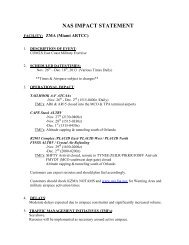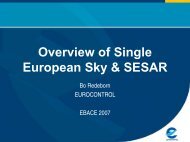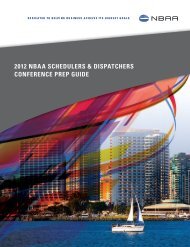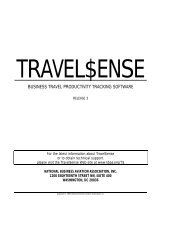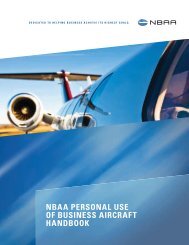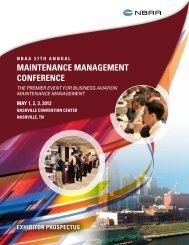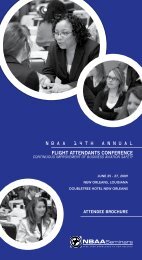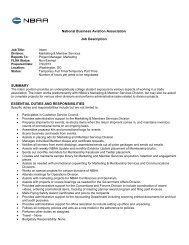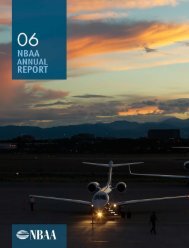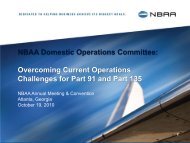PART B - CABOTAGE - NBAA
PART B - CABOTAGE - NBAA
PART B - CABOTAGE - NBAA
Create successful ePaper yourself
Turn your PDF publications into a flip-book with our unique Google optimized e-Paper software.
LARK &<br />
OMPANY<br />
REGULATION REQUIREMENTS FOR OPERATIONS TO/FROM<br />
CANADA INCLUDING <strong>CABOTAGE</strong> RESTRICTIONS AND<br />
CANADIAN TAX ISSUES<br />
William F. Clark<br />
Barrister & Solicitor<br />
Clark & Company<br />
200 Adelaide St. West Telephone: (416) 681-9900<br />
Suite 011 Facsimile: (416) 681-9500<br />
Toronto, Ontario Mobile: (647) 500-7115<br />
M5H 4E2 E-Mail: clark@yyzlaw.com<br />
CROSS-BORDER ISSUES CONFERENCE<br />
Montreal, Quebec<br />
November 18 – 19, 2010<br />
<strong>PART</strong> B - <strong>CABOTAGE</strong><br />
1
Cabotage<br />
Canada Customs and Revenue Agency<br />
www.ccra-adrc.gc.ca<br />
MEMORANDUM D3-2-1 - International Air Traffic<br />
Authorized Use of Private and Company-<br />
Owned Aircraft<br />
16. A foreign non-tax paid aircraft is restricted<br />
to international flights from a point abroad<br />
to a point or points in Canada and return.<br />
The carriage of Canadian residents to and<br />
their arrival from foreign destinations is<br />
permitted provided the flight is limited to<br />
international service.<br />
11<br />
Cabotage<br />
Canada Customs and Revenue Agency<br />
www.ccra-adrc.gc.ca<br />
MEMORANDUM D3-2-1 - International Air Traffic<br />
Authorized Use of Private and Company-Owned<br />
Aircraft<br />
17. The non-commercial operation of non-<br />
Canadian private aircraft by a non-resident of<br />
Canada is generally unrestricted. Customs<br />
procedures pertaining to these aircraft are<br />
explained in greater detail in Memorandum D2-<br />
1-1, Temporary Importation of Baggage and<br />
Conveyances by Non-Residents.<br />
12<br />
2
Cabotage<br />
Canada Customs and Revenue Agency<br />
www.ccra-adrc.gc.ca<br />
MEMORANDUM D3-2-1 - International Air Traffic<br />
Authorized Use of Private and Company-<br />
Owned Aircraft – Continued<br />
18. Non-Canadian corporate aircraft operating in<br />
Canada are restricted to operating<br />
international services into or out of Canada<br />
and are not permitted to operate point-topoint<br />
domestic services within Canada. In the<br />
performance of international service, the<br />
aircraft may stop at more than one Canadian<br />
location and disembark or re-embark<br />
13<br />
Cabotage<br />
Canada Customs and Revenue Agency<br />
www.ccra-adrc.gc.ca<br />
MEMORANDUM D3-2-1 - International Air Traffic<br />
Authorized Use of Private and Company-<br />
Owned Aircraft – Continued<br />
18. passengers, provided the passengers are the<br />
same passengers who originated outside of<br />
Canada. Similarly on the outbound portion of<br />
an international flight, the aircraft may stop at<br />
one or more locations in Canada and may<br />
disembark and re-embark passengers who are<br />
ultimately taken out of Canada as part of the<br />
outbound international service.<br />
14<br />
3
Cabotage<br />
Canada Customs and Revenue Agency<br />
www.ccra-adrc.gc.ca<br />
MEMORANDUM D3-2-1 - International Air Traffic<br />
Authorized Use of Private and Company-<br />
Owned Aircraft – Continued<br />
19. Within the definition of an international flight,<br />
Customs has traditionally allowed the uplift of<br />
Canadian passengers when their carriage was<br />
incidental to the intended or declared purpose<br />
of the flight.<br />
15<br />
Cabotage<br />
Canada Customs and Revenue Agency<br />
www.ccra-adrc.gc.ca<br />
MEMORANDUM D3-2-1 - International Air Traffic<br />
Authorized Use of Private and Company-Owned<br />
Aircraft - Continued<br />
• Example: A United States based aircraft<br />
carrying company personnel from a location in<br />
the U.S. to a branch meeting or conference in a<br />
Canadian city may, while en route to the<br />
meeting or conference, stop at another<br />
Canadian city and pick up additional personnel<br />
16<br />
4
Cabotage<br />
Canada Customs and Revenue Agency<br />
www.ccra-adrc.gc.ca<br />
MEMORANDUM D3-2-1 - International Air Traffic<br />
Authorized Use of Private and Company-Owned<br />
Aircraft - Continued<br />
who will also be attending the same meeting or<br />
conference. They may subsequently return the<br />
same Canadian passengers to the Canadian<br />
city where they were embarked, during the<br />
return portion of flight destined to a point in the<br />
United States.<br />
17<br />
Cabotage<br />
Canada Customs and Revenue Agency<br />
www.ccra-adrc.gc.ca<br />
• Note: Customs generally considers all<br />
corporate aircraft to be non-commercial<br />
operations unless specifically engaged in a<br />
commercial charter or other operation for<br />
hire or remuneration. However, some<br />
corporate operations may be classified as<br />
commercial air services under other<br />
government legislation and may be<br />
18<br />
5
Cabotage<br />
Canada Customs and Revenue Agency<br />
www.ccra-adrc.gc.ca<br />
prohibited from operating an air service<br />
between two points in Canada. Corporate<br />
operators are advised to consult with the<br />
Canadian Transportation Agency (CTA)<br />
regarding possible restrictions on carrying<br />
passengers between points in Canada .<br />
19<br />
Cabotage<br />
Canada Customs and Revenue Agency<br />
www.ccra-adrc.gc.ca<br />
MEMORANDUM D3-2-1 - International Air Traffic<br />
Authorized Use of Private and Company-Owned Aircraft -<br />
Continued<br />
20. Under no circumstances may a foreign non-tax paid<br />
aircraft enter Canada for the sole purpose of carrying<br />
passengers from point to point in Canada. In this<br />
situation, it is deemed that the aircraft is imported for<br />
that specific purpose and is not performing an<br />
international air service.<br />
20<br />
6
Cabotage<br />
Canada Customs and Revenue Agency<br />
www.ccra-adrc.gc.ca<br />
26. From time to time, non-tax paid aircraft are<br />
chartered by groups of non-residents who wish<br />
to visit several Canadian centers. Normally, the<br />
point-to-point carriage of passengers by a nontax<br />
paid non-Canadian aircraft would be<br />
considered a cabotage movement. However,<br />
such movements are allowed if the passengers<br />
originated outside of Canada and are initially<br />
brought into Canada by a carrier that is<br />
operating under a continuing tour charter.<br />
21<br />
Cabotage<br />
Canada Customs and Revenue Agency<br />
www.ccra-adrc.gc.ca<br />
MEMORANDUM D2-1-1<br />
Temporary Importation of Baggage and<br />
Conveyances by Non-Residents<br />
45. Foreign-owned corporate aircraft may be<br />
used to transport non-resident company<br />
personnel/clientele into, out of, and within<br />
Canada without any restrictions on<br />
itinerary. All movements must be for the<br />
benefit of, or<br />
22<br />
7
Cabotage<br />
Canada Customs and Revenue Agency<br />
www.ccra-adrc.gc.ca<br />
on behalf of, a non-resident of Canada, and<br />
any sales or subscriptions to be solicited<br />
must be on behalf of a business based<br />
outside of Canada. In addition, no goods or<br />
passengers may be transported for<br />
compensation, nor may goods be<br />
transported for sale.<br />
23<br />
Cabotage<br />
Canada Customs and Revenue Agency<br />
www.ccra-adrc.gc.ca<br />
46. Residents of Canada may accompany<br />
non-resident company personnel/clientele<br />
on movements from point to point in<br />
Canada only if their presence on board the<br />
aircraft is incidental to the primary purpose<br />
of the trip and no remuneration is involved.<br />
In other words, each movement of the<br />
aircraft in Canada must be for the purpose<br />
of transporting or accommodating an<br />
eligible non-resident user. In any case where<br />
24<br />
8
Cabotage<br />
Canada Customs and Revenue Agency<br />
www.ccra-adrc.gc.ca<br />
the aircraft is used to travel from point to<br />
point in Canada solely for the movement or<br />
accommodation of a resident, the aircraft is<br />
no longer eligible for the provisions of tariff<br />
item No. 9803.00.00 and becomes subject to<br />
assessment in the usual manner.<br />
25<br />
Cabotage<br />
Canada Customs and Revenue Agency<br />
www.ccra-adrc.gc.ca<br />
47. However, one-way movements into<br />
Canada to a customs-authorized airport<br />
and one-way movements out of<br />
Canada from a customs-authorized<br />
airport may be made without regard to<br />
the residential status of the passengers<br />
carried or the requirements of this<br />
Memorandum, provided no local use is<br />
made of the aircraft while it is in<br />
Canada.<br />
26<br />
9
Cabotage<br />
Canadian Transportation Agency<br />
• The transportation of passengers between<br />
points in Canada, by a U.S. airline as part of a<br />
trip originating in or destined to the United<br />
States, is international transportation and not a<br />
“cabotage” movement. When the<br />
transportation is part of a continuous<br />
international journey with stopovers at points<br />
within Canada and is covered by a single<br />
contract, the entire transportation, including the<br />
portions between points in Canada, is<br />
considered to be international.<br />
27<br />
Cabotage<br />
Canadian Transportation Agency<br />
Under this Agreement designated airlines of Canada and<br />
the United States may operate scheduled or charter<br />
flights between any point or points in the United States<br />
and any point or points in Canada and may provide<br />
stopovers at points in either territory. There is no limitation<br />
on the number of points at which such stopovers may be<br />
made. In the case of charters, there is no longer a<br />
requirement for the aircraft to remain with the charter<br />
group at the point of stopover . . . Or for the same aircraft<br />
to be<br />
used for the entire journey.<br />
28<br />
10
Cabotage<br />
Canadian Transportation Agency<br />
In view of these provisions, a United States airline<br />
may transport passengers from the United States<br />
to a first point of arrival in Canada, return to that<br />
Canadian point at a later date and transport<br />
the same group to another point in Canada for<br />
another stopover, provided that the entire<br />
transportation of the group is under a single<br />
contract with that airline for transportation<br />
which originates in, or is finally destined for a<br />
point in the United States.<br />
29<br />
Cabotage<br />
Canadian Transportation Agency<br />
The CTA would consider that the carriage of a charter<br />
group on a journey which included roundtrip<br />
transportation between two points in Canada, with<br />
stopovers at that point on both occasions, would not be<br />
an international journey. As an example, the<br />
transportation by a U.S. carrier of a charter group on a<br />
“continuous journey” from Pittsburgh to Montreal, as a<br />
stopover point and subsequently from Montreal to Toronto<br />
and return to Montreal with stopovers at each point, even<br />
if the journey ultimately continues to another point in the<br />
U.S.A., would be considered to be two separate trips, one<br />
of which would involve cabotage.<br />
30<br />
11



